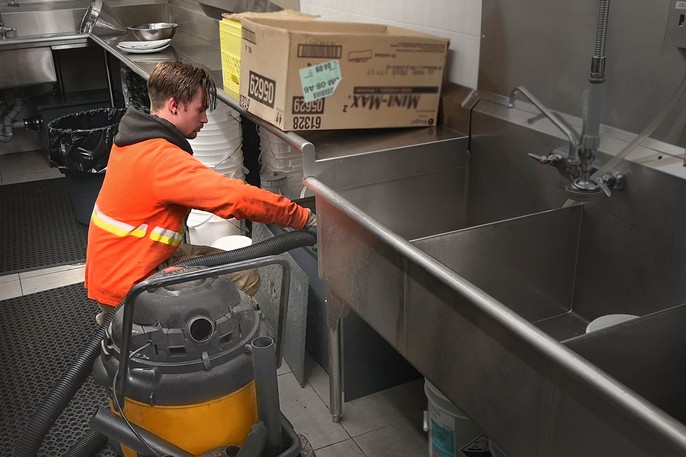Grease traps are vital components in the plumbing systems of commercial kitchens, particularly in Brooklyn, NY, and across New York City. These devices prevent fats, oils, and grease (FOG) from entering the sewer system, which can lead to blockages, environmental issues, and hefty fines. Regular maintenance, including grease trap pumping and cleaning, is crucial to ensure that these systems function efficiently. This article delves into the importance of grease trap pumping, the cleaning process, and how to choose the right service provider in Brooklyn and NYC.
What is a Grease Trap?
A grease trap, also known as a grease interceptor, is a plumbing device designed to capture and separate grease and solids from wastewater before it enters the sewer system. Typically installed in commercial kitchens, grease traps can be found in various settings, including restaurants, cafes, hotels, and catering services. These systems are essential for maintaining compliance with local health regulations and protecting the environment.
How Does a Grease Trap Work?
The functioning of a grease trap is relatively straightforward. When wastewater from the kitchen sinks, dishwashers, or other appliances flows into the grease trap, it enters a large tank where it undergoes a separation process. The tank is designed to allow grease and oil, which are lighter than water, to rise to the top. Meanwhile, heavier solids settle at the bottom. This process creates three layers:
- Grease Layer: This is the top layer, consisting of fats, oils, and grease.
- Wastewater Layer: The middle layer contains the wastewater that will eventually flow out of the trap and into the sewer system.
- Sludge Layer: The bottom layer is made up of solid waste that has settled over time.
For optimal performance, grease traps must be pumped and cleaned regularly to remove the accumulated grease and solids.
Why is Grease Trap Pumping Important?
- Preventing Clogs: Over time, grease accumulates in the trap, leading to clogs that can cause wastewater to back up into the kitchen. This not only disrupts operations but can also lead to unsanitary conditions.
- Avoiding Fines: New York City has strict regulations regarding grease disposal. Failing to maintain your grease trap can result in fines and penalties from local authorities.
- Extending Equipment Life: Regular grease trap pumping and cleaning help prolong the lifespan of your plumbing systems and appliances by preventing blockages and reducing wear and tear.
- Environmental Responsibility: Proper grease disposal is crucial for preventing environmental pollution. When grease enters the sewer system, it can cause significant damage to municipal treatment facilities and waterways.
- Improving Air Quality: Accumulated grease can produce foul odors in the kitchen, affecting air quality. Regular pumping and cleaning help mitigate these odors.
The Grease Trap Pumping Process
The grease trap pumping process typically involves the following steps:
1. Assessment
Before any work begins, a qualified technician will assess the grease trap to determine its condition and the extent of cleaning required. This assessment helps identify potential issues that may need to be addressed during the service.
2. Pumping
Using specialized equipment, the technician will pump out the accumulated grease and solids from the trap. This process usually involves removing the top layer of grease first, followed by the wastewater and sludge.
3. Cleaning
After pumping, the technician will thoroughly clean the interior of the grease trap, removing any remaining residue. This may involve scraping the walls and bottom of the tank to ensure all grease and solids are removed.
4. Disposal
Proper disposal of the extracted waste is crucial. Reputable service providers will follow local regulations for disposing of grease and solids, often transporting it to a licensed facility for recycling or treatment.
5. Inspection and Recommendations
Once the cleaning is complete, the technician will inspect the grease trap for any signs of damage or wear. They may offer recommendations for maintenance or repairs to ensure the trap operates effectively.
Choosing the Right Grease Trap Service Provider in Brooklyn, NY
When it comes to grease trap pumping and cleaning, choosing the right service provider is crucial for maintaining compliance and ensuring the efficiency of your plumbing system. Here are some factors to consider:
1. Experience and Expertise
Look for a company with a proven track record in grease trap services. Experienced technicians will have the skills and knowledge to handle various grease traps and comply with local regulations.
2. Licensing and Insurance
Ensure the company is licensed and insured. This protects you from liability in case of accidents during the pumping and cleaning process. A reputable provider will also comply with all local regulations regarding waste disposal.
3. Reputation and Reviews
Research customer reviews and testimonials to gauge the company’s reputation. Online platforms such as Google, Yelp, and social media can provide insights into their quality of service and customer satisfaction.
4. Range of Services
Consider a provider that offers a comprehensive range of services, including regular maintenance, inspections, and emergency services. This ensures that all your grease trap needs can be met under one roof.
5. Transparent Pricing
Request quotes from multiple companies to compare pricing. Be cautious of unusually low prices, as they may indicate subpar service. A reputable company will provide clear and fair pricing based on the services rendered.
Conclusion
Grease trap pumping and cleaning are essential for any commercial kitchen in Brooklyn, NY, and the wider NYC area. Regular maintenance not only prevents costly clogs and fines but also protects the environment and ensures the smooth operation of your business. By choosing a reliable service provider, you can ensure that your grease trap remains in optimal condition, allowing you to focus on what you do best—serving your customers. Remember to prioritize regular pumping and cleaning to maintain compliance with local regulations and safeguard your plumbing systems.



